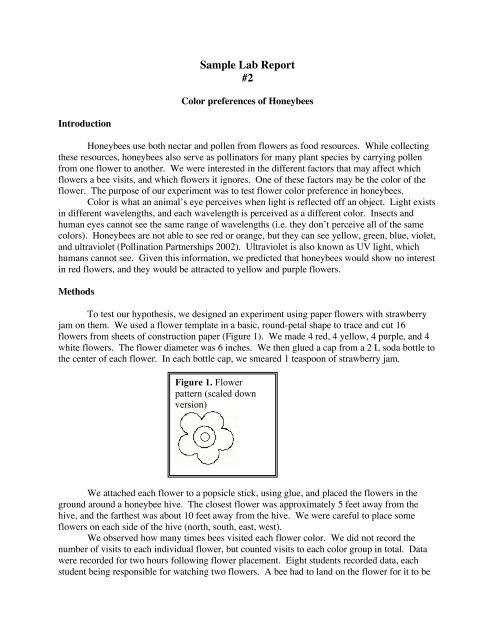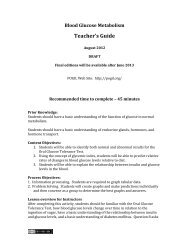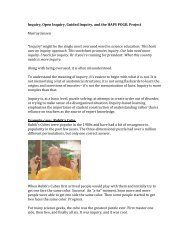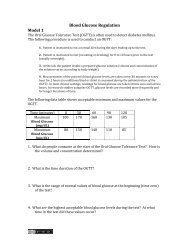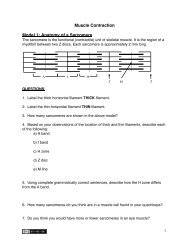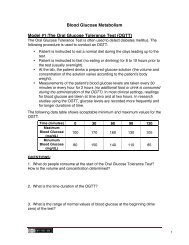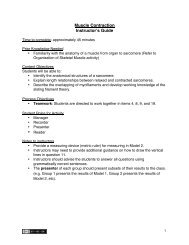Create successful ePaper yourself
Turn your PDF publications into a flip-book with our unique Google optimized e-Paper software.
Introduction<br />
<strong>Sample</strong> <strong>Lab</strong> <strong>Report</strong><br />
#2<br />
Color preferences of Honeybees<br />
Honeybees use both nectar and pollen from flowers as food resources. While collecting<br />
these resources, honeybees also serve as pollinators for many plant species by carrying pollen<br />
from one flower to another. We were interested in the different factors that may affect which<br />
flowers a bee visits, and which flowers it ignores. One of these factors may be the color of the<br />
flower. The purpose of our experiment was to test flower color preference in honeybees.<br />
Color is what an animal’s eye perceives when light is reflected off an object. Light exists<br />
in different wavelengths, and each wavelength is perceived as a different color. Insects and<br />
human eyes cannot see the same range of wavelengths (i.e. they don’t perceive all of the same<br />
colors). Honeybees are not able to see red or orange, but they can see yellow, green, blue, violet,<br />
and ultraviolet (Pollination Partnerships 2002). Ultraviolet is also known as UV light, which<br />
humans cannot see. Given this information, we predicted that honeybees would show no interest<br />
in red flowers, and they would be attracted to yellow and purple flowers.<br />
Methods<br />
To test our hypothesis, we designed an experiment using paper flowers with strawberry<br />
jam on them. We used a flower template in a basic, round-petal shape to trace and cut 16<br />
flowers from sheets of construction paper (Figure 1). We made 4 red, 4 yellow, 4 purple, and 4<br />
white flowers. The flower diameter was 6 inches. We then glued a cap from a 2 L soda bottle to<br />
the center of each flower. In each bottle cap, we smeared 1 teaspoon of strawberry jam.<br />
Figure 1. Flower<br />
pattern (scaled down<br />
version)<br />
We attached each flower to a popsicle stick, using glue, and placed the flowers in the<br />
ground around a honeybee hive. The closest flower was approximately 5 feet away from the<br />
hive, and the farthest was about 10 feet away from the hive. We were careful to place some<br />
flowers on each side of the hive (north, south, east, west).<br />
We observed how many times bees visited each flower color. We did not record the<br />
number of visits to each individual flower, but counted visits to each color group in total. Data<br />
were recorded for two hours following flower placement. Eight students recorded data, each<br />
student being responsible for watching two flowers. A bee had to land on the flower for it to be
considered a visit to that flower. If a bee landed on the paper flower without touching the bottle<br />
cap, we still counted it as a visit.<br />
Our independent variable was the flower color. The control in this experiment was the<br />
white flower group, as white represents light of all wavelengths together. Our dependent<br />
variable was the number of visits each color group received.<br />
Results<br />
Our results show that the white flowers received the most visits, with red a close second.<br />
The yellow flowers received the least visits (Table 1; Figure 2). There is no clear pattern or<br />
trend seen in Figure 2.<br />
Figure 2.<br />
Number of Visits<br />
Table 1. Number of visits to each color.<br />
Color Number of Visits<br />
White 25<br />
Red 24<br />
Yellow 18<br />
Purple 20<br />
30<br />
25<br />
20<br />
15<br />
10<br />
5<br />
0<br />
Number of visits to each color<br />
White Red Yellow Purple<br />
Color
Discussion<br />
Our results did not support our hypothesis that honeybees would prefer yellow and purple<br />
flowers over red flowers. The number of visits for each color, including the control, were fairly<br />
similar. It is possible that color is not the most important factor in flower attraction. Honeybees<br />
may use chemical cues (i.e. smell) to locate nectar and pollen. Since the same strawberry jam<br />
was on each of our paper flowers, maybe the bees were equally attracted to all of our flowers. It<br />
is also possible that the construction paper we used does not reflect light at the same intensity, to<br />
a bee’s eye, as real flower petals. Also, we may have placed the flowers too close together,<br />
creating a food patch that made it too easy for a bee to “jump” from one flower to the next. The<br />
bee could sample all of the flowers with relatively little effort, so perhaps this overrode any color<br />
preferences. It would be a good idea to carry out a similar study watching honeybees in natural<br />
flower patches. We may have manipulated too many variables at one time in our experiment.<br />
References<br />
Pollination Partnerships. 2002. Plants and Pollinators: Exploring Adaptations. Fort Worth:<br />
Botanical Research Institute of Texas. 10 pp.


